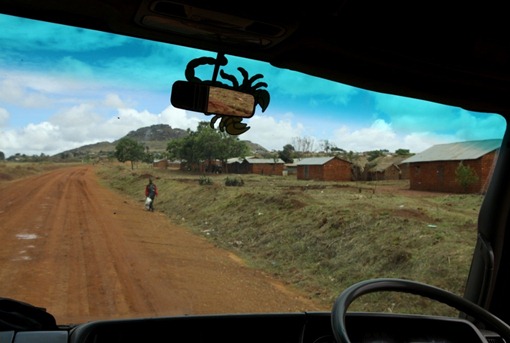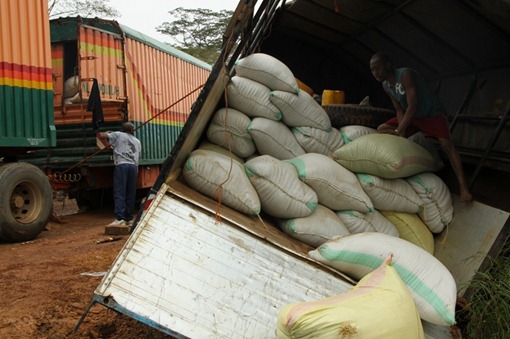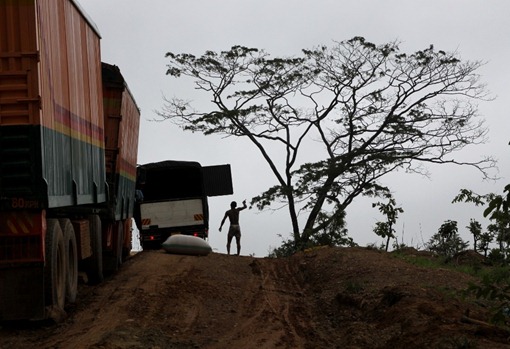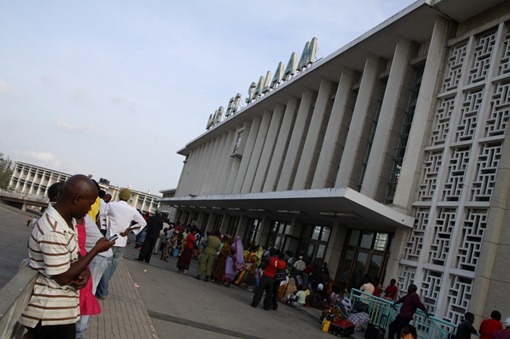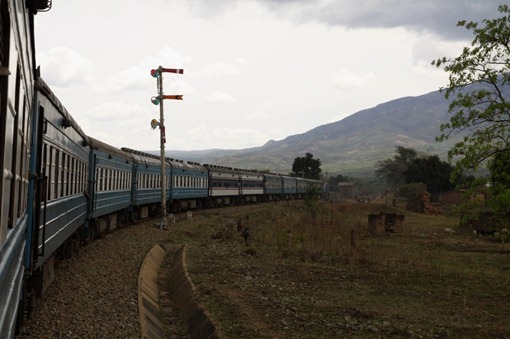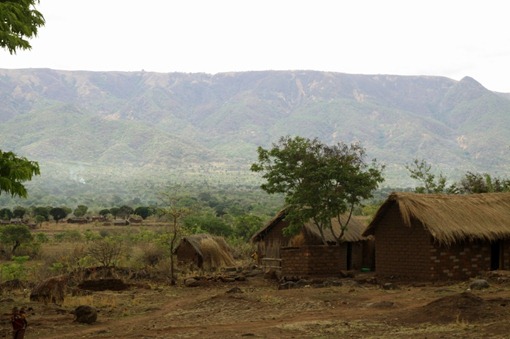November 23, 2009
When it rains…/ Quand il pleut …
In order to pass the far western regions of Tanzania, as we had done in many countries before, we had only to choose to bargain with truck drivers who pass by that way to include us in their cargos. For Eugénie and I, this is often a preferred method of travel when compared to buses, since it oft gives us the opportunity to both speak at lengths with people familiar with the region, as well as to dispel myths and misunderstandings surrounding white travelers generally.
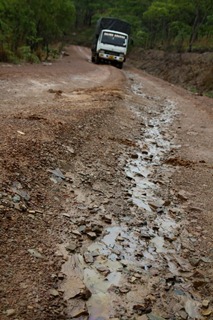 Once, moving northwards, you reach the small but sympathetic regional headquarters of Sumbawanga, there is no longer any “public” transportation in the direction to Kigoma. (Actually, there is one bus from Sumbawanga to Mpanda daily, though is twice the price as a truck. After Mpanda, you must switch to a trucker anyhow or stay a few days for the train to arrive bringing you back to Tabora before switching to another train a few days later still to Kigo ma). To cross to Mpanda is not particularly difficult or exhausting as the roads are by no means the worst one could find in the country, though is a full days expedition expected to be full of flat tires and overheating engines. The traverse brings you right through the center of Katavi National Park without an entrance charge (though the number of bribes paid to the various traffic police sprinkled about the roads to Mpanda is a shocking thing to witness – paid to avoid the fines for taking extra passengers). The sides of the roads fill with Tanzania’s largest communities of elephants and plenty of strange towering giraffes to keep you occupied. It was on this passage that we spoke extensively with one truck’s worker absolutely exhilarated by the beauty his country had to offer. Upon reaching Mpanda it is clear to see that it is a town constructed for transients, truckers and a few lost souls. Less attractive than its regional counterpart to the south and less welcoming to boot. It is no easy task to find the right curb to rest the following morning waiting for a truck to pass in the right direction, but be prepared whence you find it, to wait with everyone else as many hours as it takes before something passes your way. Generally there are many local government 4x4’s passing who will pick up passengers for a fee, but most stay close by the villages surrounding Mpanda, and don’t continue through the rough mountain passes just north. Once you find a truck (going either to Uvinza or Kasulu) the real adventure begins.
Once, moving northwards, you reach the small but sympathetic regional headquarters of Sumbawanga, there is no longer any “public” transportation in the direction to Kigoma. (Actually, there is one bus from Sumbawanga to Mpanda daily, though is twice the price as a truck. After Mpanda, you must switch to a trucker anyhow or stay a few days for the train to arrive bringing you back to Tabora before switching to another train a few days later still to Kigo ma). To cross to Mpanda is not particularly difficult or exhausting as the roads are by no means the worst one could find in the country, though is a full days expedition expected to be full of flat tires and overheating engines. The traverse brings you right through the center of Katavi National Park without an entrance charge (though the number of bribes paid to the various traffic police sprinkled about the roads to Mpanda is a shocking thing to witness – paid to avoid the fines for taking extra passengers). The sides of the roads fill with Tanzania’s largest communities of elephants and plenty of strange towering giraffes to keep you occupied. It was on this passage that we spoke extensively with one truck’s worker absolutely exhilarated by the beauty his country had to offer. Upon reaching Mpanda it is clear to see that it is a town constructed for transients, truckers and a few lost souls. Less attractive than its regional counterpart to the south and less welcoming to boot. It is no easy task to find the right curb to rest the following morning waiting for a truck to pass in the right direction, but be prepared whence you find it, to wait with everyone else as many hours as it takes before something passes your way. Generally there are many local government 4x4’s passing who will pick up passengers for a fee, but most stay close by the villages surrounding Mpanda, and don’t continue through the rough mountain passes just north. Once you find a truck (going either to Uvinza or Kasulu) the real adventure begins.
 The roads, taken on their own merits, cannot be said to be the worst we’ve encountered. But given the height of the rain season, the narrow room for a single truck to maneuver through the soft sands of her mountains, the impatience and ignorance of certain truckers, the tendencies to overload, and the swiftness with which night falls at such elevations, we can safely say that they are not the best. To recount our personal history is perhaps the best way to explain how these factors play to one another.
The roads, taken on their own merits, cannot be said to be the worst we’ve encountered. But given the height of the rain season, the narrow room for a single truck to maneuver through the soft sands of her mountains, the impatience and ignorance of certain truckers, the tendencies to overload, and the swiftness with which night falls at such elevations, we can safely say that they are not the best. To recount our personal history is perhaps the best way to explain how these factors play to one another.
Eugénie and I were perhaps halfway through our trip, one which should normally only be eight-ten hours to pass to Uvinza from Mpanda. We had almost ascended to the highest elevation we would reach all day when it began to rain. These “seasonal” rains which come as rapturous as the thunder itself, and last only half an hour or so before the sun cuts through again. But in this short time lands are made into thick broths and rivers form as in some ancient ecstatic Genesis. The best way to deal with them, whenever possible is to stop whatever you are doing, hide from the rain, then continue once their veins wither away. This is not what our dear driver had in mind. Not even when he noticed ahead of himself two trucks (wisely parked waiting out the worst of it). He pushed up the hill faster than before. Not even when he saw a two-bodied truck derailed and taking half the narrow route ahead. This is when we, along with the other truck workers and two other female passengers asked if we could get out of the truck to allow him to pass the poor truck with his own life at sake. He graciously waited for us to find cover from the torrents, observed the state of the road by foot, and then reinstalled himself within to barge ahead with impressive confidence. Needless to say, a few moments later, all the trucks workers rushed to pull him from the truck which was fearful to roll down the hill if the sand beneath gave way even another inch.
With the truck effectively on its side, and the back end a few meters down the hills face, there was little to do but to secure it tightly with ropes to the truck which had previously 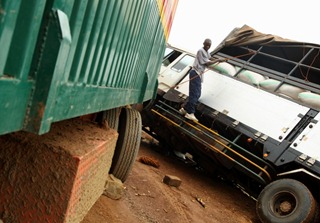 derailed in the same place to keep it from further falling. It proved useless to try to drive it out, so we began unloading all 100 sacks of 80kls of shelled rice from its hind. While this was happening, the women of all the (now) trapped trucks began fetching firewood, pitching tents with Unicef and UNHRC tarps, and cooking ugali and fish for everyone present (to show the habitual nature of such pauses). The idea quickly became to unload the truck, the build a new road by constructing a base of large rocks and branches, filling in with the soft sands and lifting the trucks behind up little by little with the combined jacks of each truck until a temporary road could be driven on.
derailed in the same place to keep it from further falling. It proved useless to try to drive it out, so we began unloading all 100 sacks of 80kls of shelled rice from its hind. While this was happening, the women of all the (now) trapped trucks began fetching firewood, pitching tents with Unicef and UNHRC tarps, and cooking ugali and fish for everyone present (to show the habitual nature of such pauses). The idea quickly became to unload the truck, the build a new road by constructing a base of large rocks and branches, filling in with the soft sands and lifting the trucks behind up little by little with the combined jacks of each truck until a temporary road could be driven on.
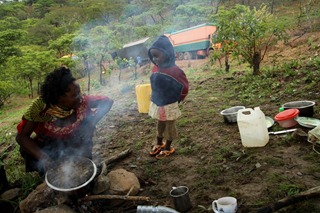 In the meantime, a mother made maize porridge over the fire for her two little girls (daughters of another driver). Local inhabitants arrived from time to time to take water from the river in the valley below, and some stopped to sell we stranded ones some vegetables and milk from their farms. The idea had been to move the double-bodied truck firstly, then drag our truck onto the street again. But unfortunately, their truck was not just derailed, but actually broken and expected to be stuck there for three more days waiting for a new part to come and be installed. Eugénie offered tea and ginger to the mounting cuisine, but apparently even in such circumstances, Tanzanians refuse to drink tea without sugar, so it was turned away graciously. The women collected the rain waters skimming from the tarps into three
In the meantime, a mother made maize porridge over the fire for her two little girls (daughters of another driver). Local inhabitants arrived from time to time to take water from the river in the valley below, and some stopped to sell we stranded ones some vegetables and milk from their farms. The idea had been to move the double-bodied truck firstly, then drag our truck onto the street again. But unfortunately, their truck was not just derailed, but actually broken and expected to be stuck there for three more days waiting for a new part to come and be installed. Eugénie offered tea and ginger to the mounting cuisine, but apparently even in such circumstances, Tanzanians refuse to drink tea without sugar, so it was turned away graciously. The women collected the rain waters skimming from the tarps into three 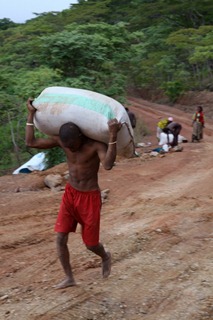 large plastic oil barrels to use for cooking, and made piles of dry branches in one corner of the “kitchen”. As the light fell, the distant yelps and hoots of the energetic Sukuma tribe on the other side of the rocks face echoed wildly.
large plastic oil barrels to use for cooking, and made piles of dry branches in one corner of the “kitchen”. As the light fell, the distant yelps and hoots of the energetic Sukuma tribe on the other side of the rocks face echoed wildly.
Eugénie and I slept in our small tent that night while everyone else slept in nooks of the various trucks (at that point numbering five) blocked on the street, or huddled together under the tarps as the rain continued to come and go in exuberant bursts throughout the night. By morning a number of 4x4’s owned by rich Tanzanians arrived at our mess and abruptly turned around to find alternative routes on the mountains. Finally, around 3:30 pm the double-bodied truck was moved if even only slightly forward, allowing a third truck to pass ours and eventually drag it from the mountains side back to the road. Then, as each truck left joyfully, we began to load the truck with the sacks of rice again. But since the driver now feared that with the weight we would get stuck in the mud before reaching the peak of the incline ahead of us, he filled it only halfway, drove to the peak, then made his two young assistants carry the profound bags one by one 90 meters to the trucks new location.
All the unloading, reloading of the rice, the building of a road, the dragging of the truck, the blockage of every other truck on the road, and 24 hours of wasted time could have been avoided had our driver a bit of patience and consideration for the rapidity of the rain. But in the end, it took only five or so more hours of driving to reach Uvinza, where we spent the night and waited for yet another transport the following day to Kigoma. Though we are used to such setbacks as these, it is such problems of transportation which keeps the west of Tanzania void of not only tourism, but food, medical supplies, equipment and work force.
Pour traverser certaines régions reculées de la Tanzanie, le voyageur n’a d’autre choix que celui de trouver une petite place dans un camion rempli de riz ou de haricots. Après avoir tenté l’expérience en Ethiopie et au Kenya, nous poursuivons l’aventure à l’Ouest du pays, en remontant les rives du lac Tanganyika. Ce moyen de transport particulier permet de prendre des routes de traverse et aussi de lutter contres les légendes populaires qui vous assurent que «oui, oui, les blancs, les muzungus ne voyagent qu’en avion ou en bus delux».
Une fois rejointe la petite capitale régionale de Sumbawanga, les transports en commun disparaissent. Reste la possibilité de prendre un bus jusqu’à Mpanda (dont le prix de la course est deux fois plus cher que le camion) puis d’attendre le train pour Tabora qui fera ensuite demi-tour vers Kigoma.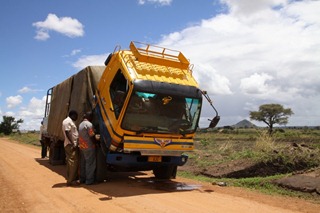 Patience et calme deviennent alors des atouts indispensables. Bien que la route qui aille jusqu’à Mpanda ne soit pas la pire d’Afrique de l’Est, partir sur la base d’un pneu crevé et de quelques surchauffes de moteur est essentiel, il faut donc compter une bonne journée de trajet. Parce que les camions n’ont en théorie pas de droit de transporter des passagers, les pauses bakchich sont aussi à prévoir. Le premier policier demande en général 2000 tsh ($1,5) et le second 3000 ($2,3) « c’est mieux que les 20 000 tsh ($15) d’amende !» s’exclame le passager à coté du chauffeur qui sert d’intermédiaire. La route traverse le parc national Katavi dont les girafes et les troupeaux d’éléphants fascinent les tanzaniens à bord. La petite ville de Mpanda est un passage quasi obligatoire pour les camionneurs et les voyageurs. Les auberges y sont nombreuses et les clients n’y font que passer.
Patience et calme deviennent alors des atouts indispensables. Bien que la route qui aille jusqu’à Mpanda ne soit pas la pire d’Afrique de l’Est, partir sur la base d’un pneu crevé et de quelques surchauffes de moteur est essentiel, il faut donc compter une bonne journée de trajet. Parce que les camions n’ont en théorie pas de droit de transporter des passagers, les pauses bakchich sont aussi à prévoir. Le premier policier demande en général 2000 tsh ($1,5) et le second 3000 ($2,3) « c’est mieux que les 20 000 tsh ($15) d’amende !» s’exclame le passager à coté du chauffeur qui sert d’intermédiaire. La route traverse le parc national Katavi dont les girafes et les troupeaux d’éléphants fascinent les tanzaniens à bord. La petite ville de Mpanda est un passage quasi obligatoire pour les camionneurs et les voyageurs. Les auberges y sont nombreuses et les clients n’y font que passer.
Trouver un camion pour en sortir n’est pas toujours aisé. Il faut se rendre au point de rassemblement à la sortie de la ville où les véhicules désireux d’embarquer des passagers contre quelques milliers de shillings s’arrêtent. L’attente peut être longue mais fort heureusement les faiseuses de thé et de petits beignets de riz frits ont installé leurs stands au bon endroit. Le chauffeur klaxonne à grand bruit en hurlant le nom du lieu où il se rend, les voyageurs intéressés se précipitent et débutent alors les négociations. Une fois le camion trouvé et les pourparlers terminés, l’aventure peut commencer. La banquette arrière de la cabine qui sert de couchette au chauffeur n’est pas des plus confortables. Sur la nôtre se trouvent deux dames déjà bien installées, une demi douzaine de bouteilles d’eau, un gros sac de riz et des cassaves terreuses. Il faut se faire une place. Même si relativement cabossée, la route qui s’ouvre devant nous est correcte. Mais, en pleine saison des pluies, sur des chaussées de terre étroites et sinueuses, avec l’impatience et l’ignorance de certains chauffeurs ainsi que leur légère tendance à surcharger les camions, c’est une véritable expédition qui se met en place. Il faut en moyenne compter huit-dix heures de trajet entre Mpanda est Uvinza. Mais toutes ces moyennes et ces théories n’étant que des belles paroles, laissez-moi vous conter notre épopée à travers la boue.
Notre camion sautillant circule depuis environ cinq heures, les jambes pliées et le dos courbé, l’arrivée se fait désirer. Alors que le véhicule se présente au pied d’une pente plutôt vertigineuse, la pluie qui avait cessé depuis quelques minutes reprend de plus belle. Cette pluie lourde qui refroidit l’atmosphère et empêche toute visibilité, elle dure en général une vingtaine de minutes avant de laisser la place aux éclaircies. Ces quelques minutes suffissent à transformer le terrain en un véritable marécage marronnâtre, des torrents se forment sur le bas coté et démolissent encore plus ce qui reste de la piste.
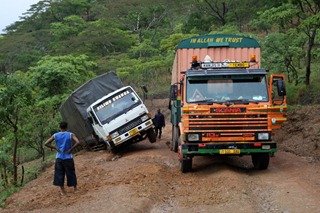 Le mieux à faire est alors d’arrêter le moteur et d’attendre que la bourrasque passe et que les torrents se tarissent. Notre chauffeur, qui pourtant n’a pas manqué de zèle lors de ses diverses pauses chronophages en a décidé autrement. Un gros fourgon arrêté juste devant et un autre camion bloqué, remorque reversée dans le ravin ne le feront pas réfléchir d’avantage, il est prêt à y aller. Qu’il lance son bolide et ses tonnes de riz en avant, il ne le fera ni avec notre peau ni avec notre baluchon à bord ! Le moteur ronfle, un nuage de fumée noire envahit l’atmosphère, le camion se lance au bord du précipice pour tenter de doubler l’autre véhicule. Quelques secondes plus tard les trois assistants tentent de rattraper le camion qui manque de sortir de la route et rouler jusqu’au petit ruisseau qui coule plusieurs mètres en contrebas. Une fois le camion à moitié dans le vide il n’y a plus grand-chose à faire si ce n’est tenter de le sécuriser en le liant à l’autre engin. Il est aussi temps de commencer à réfléchir. Ainsi nous obtenons la réponse à cette question obsédante : pourquoi chaque camion a-t-il autant d’employés à son bord ? La réponse est à présent évidente : pour parer à ce genre de situation. En Europe le chauffeur aurait appelé un numéro de secours et attendu l’arrivée de renforts, ici rien de cela, le chauffeur et ses acolytes vont devoir se sortir de cette situation seuls, que cela prenne une heure ou trois jours.
Le mieux à faire est alors d’arrêter le moteur et d’attendre que la bourrasque passe et que les torrents se tarissent. Notre chauffeur, qui pourtant n’a pas manqué de zèle lors de ses diverses pauses chronophages en a décidé autrement. Un gros fourgon arrêté juste devant et un autre camion bloqué, remorque reversée dans le ravin ne le feront pas réfléchir d’avantage, il est prêt à y aller. Qu’il lance son bolide et ses tonnes de riz en avant, il ne le fera ni avec notre peau ni avec notre baluchon à bord ! Le moteur ronfle, un nuage de fumée noire envahit l’atmosphère, le camion se lance au bord du précipice pour tenter de doubler l’autre véhicule. Quelques secondes plus tard les trois assistants tentent de rattraper le camion qui manque de sortir de la route et rouler jusqu’au petit ruisseau qui coule plusieurs mètres en contrebas. Une fois le camion à moitié dans le vide il n’y a plus grand-chose à faire si ce n’est tenter de le sécuriser en le liant à l’autre engin. Il est aussi temps de commencer à réfléchir. Ainsi nous obtenons la réponse à cette question obsédante : pourquoi chaque camion a-t-il autant d’employés à son bord ? La réponse est à présent évidente : pour parer à ce genre de situation. En Europe le chauffeur aurait appelé un numéro de secours et attendu l’arrivée de renforts, ici rien de cela, le chauffeur et ses acolytes vont devoir se sortir de cette situation seuls, que cela prenne une heure ou trois jours.
Alors que les hommes commencent à renforcer la route, les femmes ont rejoint le petit camp déjà monté par les précédents arrivants. Une bâche de HCR à été tendue, un feu allumé et de gros bidons récupèrent l’eau qui coule à flot du toit de fortune. J’offre notre réserve de thé au gingembre à la cuisinière,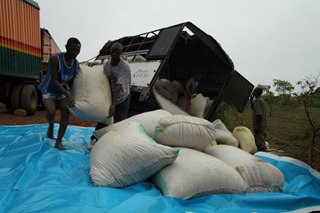 cette dernière ravie par l’idée me fait comprendre que si je n’ai pas aussi du sucre, il n’y aura pas de thé. Il n’y aura donc pas de thé. Du coté du camion une première étape est indispensable, il va falloir vider les cent sacs de 80 kg de riz entassés à l’arrière. L’opération en plus d’être longue est extrêmement laborieuse. Les femmes et les faibles partent alors à la recherche de gros cailloux et de branches pour combler les crevasses boueuses formées par le passage en force du camion. Une jeune femme commence à préparer de l’ugali et du poisson pour le repas du soir. Les marmites, les assiettes et les tasses, tout a été prévu, il est en effet rare pour les tanzaniens de se lancer dans ce genre de périple sans un kilo de riz et quelques bananes. On ne sait jamais. Les femmes se concentrent autour du feu et les techniciens éternuent au loin. A l’heure du crépuscule s’élèvent les chants des Sukuma, l’une des dernières tribus locales vivant reculées dans les montagnes. Tous les mécaniciens lèvent la tête et écoutent, captivés par ses rythmes mythiques qui les fascinent. Il fait à présent nuit, la forêt qui s’étend au loin à disparu dans le noir du ciel étoilé. Les manœuvres se poursuivent dans la nuit à la lumière d’une lampe de poche, le chauffeur tente de redresser le camion à l’aide d’un cric qui s’enfonce dans le sol, le déchargement continue. Alors que les hommes s’endorment dans les camions, les deux femmes enroulées dans leurs
cette dernière ravie par l’idée me fait comprendre que si je n’ai pas aussi du sucre, il n’y aura pas de thé. Il n’y aura donc pas de thé. Du coté du camion une première étape est indispensable, il va falloir vider les cent sacs de 80 kg de riz entassés à l’arrière. L’opération en plus d’être longue est extrêmement laborieuse. Les femmes et les faibles partent alors à la recherche de gros cailloux et de branches pour combler les crevasses boueuses formées par le passage en force du camion. Une jeune femme commence à préparer de l’ugali et du poisson pour le repas du soir. Les marmites, les assiettes et les tasses, tout a été prévu, il est en effet rare pour les tanzaniens de se lancer dans ce genre de périple sans un kilo de riz et quelques bananes. On ne sait jamais. Les femmes se concentrent autour du feu et les techniciens éternuent au loin. A l’heure du crépuscule s’élèvent les chants des Sukuma, l’une des dernières tribus locales vivant reculées dans les montagnes. Tous les mécaniciens lèvent la tête et écoutent, captivés par ses rythmes mythiques qui les fascinent. Il fait à présent nuit, la forêt qui s’étend au loin à disparu dans le noir du ciel étoilé. Les manœuvres se poursuivent dans la nuit à la lumière d’une lampe de poche, le chauffeur tente de redresser le camion à l’aide d’un cric qui s’enfonce dans le sol, le déchargement continue. Alors que les hommes s’endorment dans les camions, les deux femmes enroulées dans leurs 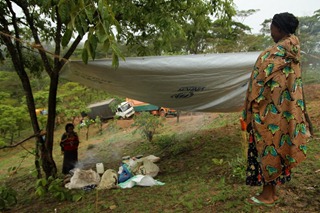 kangas (tissu traditionnel tanzanien) s’endorment blotties au coin du feu. La pluie s’abat violemment à deux reprises au cours de la nuit sur le campement.
kangas (tissu traditionnel tanzanien) s’endorment blotties au coin du feu. La pluie s’abat violemment à deux reprises au cours de la nuit sur le campement.
Au petit matin la forêt verte est enrobée dans une brume épaisse. Le camion quand à lui est toujours aussi bancal. De l’eau et des haricots sont aussitôt mis à chauffer sur le feu. Les femmes prennent alors la route de la rivière, on y fait la vaisselle et la lessive. Le véhicule n’est pas prêt de repartir, tout le monde le sait sauf ce technicien qui assure que «oui, oui, dans une heure on reprend la route», alors autant mettre son temps à profit, des piles d’habits sortis de l’on ne sait où sont alors lavées dans a rivière avant d’être mises à sécher sur des buissons. Le premier camion décoré du message divin «In Allah we trust» est enfin redressé et mis sur le bas coté ce qui permet de dégager la route, les petits véhicules peuvent à présent passer. Des 4x4 s’arrêtent et jettent un œil à la situation avant de reprendre la route en nous laissant quelques fruits. Certains viennent prêter main forte. Un bol de porridge et une assiette de riz-haricots sont servis pour le repas. Vers 14h le premier camion repart, le nôtre est ensuite redressé mais il est à présent temps de recharger les tonnes de riz à bord. Par peur de rester bloqué dans la pente, le camion n’est rempli qu’à moitié, les employés ont alors le reste des sacs à transporter sur leurs dos et sur plusieurs mètres, jusqu’au sommet de la route.
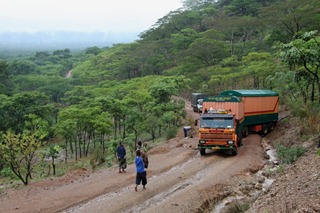 Le ciel menace depuis un certain temps, alors inévitablement la pluie vient ralentir encore un peu plus le chargement sans fin. A 16 heures, soit exactement 24 heures après l’incident le camion démarre à nouveau. Le chargement et le déchargement de 8 tonnes de riz, le travail de reconstruction d’une route, de nombreuses tentatives pour redresser le camion, la perte de 24 heures, une nuit trempée et l’épuisement de 3 jeunes employés auraient pu être évité si le chauffeur malgré tout fort sympathique avait dénié considérer la situation avec un peu plus de pragmatisme. Tout le monde exulte de joie après tous ces efforts, mais, restons modérés, il n’est pas dit que le camion ne s’embourbe pas à nouveau dans quelques kilomètres…
Le ciel menace depuis un certain temps, alors inévitablement la pluie vient ralentir encore un peu plus le chargement sans fin. A 16 heures, soit exactement 24 heures après l’incident le camion démarre à nouveau. Le chargement et le déchargement de 8 tonnes de riz, le travail de reconstruction d’une route, de nombreuses tentatives pour redresser le camion, la perte de 24 heures, une nuit trempée et l’épuisement de 3 jeunes employés auraient pu être évité si le chauffeur malgré tout fort sympathique avait dénié considérer la situation avec un peu plus de pragmatisme. Tout le monde exulte de joie après tous ces efforts, mais, restons modérés, il n’est pas dit que le camion ne s’embourbe pas à nouveau dans quelques kilomètres…
Bienvenu à bord du TAZARA
Friday, the 6th of November 2009, 8 am: All major boulevards of Dar es-Salaam are completely jammed, bogged down by the lethargic tonnage of passengers crammed tightly into each Dala-Dala. But not a single eye could claim to miss the far-away castle in the cloud, as it is; the enormous white building of such excessive affect to its surroundings; with what is no less than a pure communist architectural trophy in Africa. This structure, from the summit of the avenue, is identifiable too for the simple six letters to which were first planted as a divination of its primary objectives since its conception: T-A-Z-A-R-A (TA-nzanian ZA-mbian RA-ilways). A structure whose poetic statement in contradiction to the grandeur of the days of colonialism endures (the brilliance of Nyerere).
It's long parking lot, extending to the rare limits of vision, had not a single vehicle filling its assuring grills (excepting two or three belonging to its office employees). Tazara is the train line which connects D ar es-Salaam twice weekly to the frontier of Zambia, and stops just kilometers from the border of Malawi. This morning, the station is chillingly empty, widening further the impressionable strength of its monumental staircase leading to the platform. The decors surrounding the building are the epic portraits of presidents and officials since the independence of Tanzania. The small wooden ticket windows, undulating beneath incredible wood and enameled fans, stand with great readiness for a sudden assault of customers. The next train departs Tuesday at 3:50 pm (as if 4:00 pm should sound too amateurish for such an established line). Tazara is a grand symbol of the years when Chino-African co-operations were rarer but much more fashionable than they are today. It was between 1970 and 1975 when some 20,000 Chinese and 30,000 Tanzanians together constructed the whole 1870 km of this line (through some deep country rarely seen by mankind).
For many years, it's circulation was composed of two different trains; the express, and the “normal.” Today, the “normal” train has been left to its well deserved retirement, meaning that any travel between Dar es-Salaam and Mbeya (our destination, the last stop in Tanzania before the border stop) takes just over 24 hours. The line, which intentionally crosses the Selous National Reserve Park, is still in many cases the only means of access to certain regions of the country deeply situated in the bush (far from a single road). Its construction accounted for the impressive development of 300 viaducts, 147 stations, and 24 stone tunnels.
Tuesday, the 10th of November 2009, 3:00 pm: A message written in white chalk upon a blackboard plaque welcomes all passengers who were this time cluttering together each with her/his respective suitcases, bags, boxes, bundles, and this seasons popular vagabond accessories. Following an apology -- a “problem” left unexplained-- it was written that rather than the expected departure time of a strict 3:50 pm sharp, the train would depart at 6:00 pm. That said, it will leave the SAME day. What a superb stroke of luck we have on the continent! The small annoyance of the delay only briefly hid the great upset of our day: all street vendors and hawkers of coffee, cookies, hard-boiled eggs, newspapers, socks, plastic sandals, funny bottle openers and provocative nail clippers (and the such we adore so on such occasions) are all forbidden from entering the grounds of the station (and even on the train itself). What insanity, that which solely makes these constant periods of wait in Africa just barely bearable and amusing, is forbidden! Scandalous.
 A question which continues to obsess me: of what logic impels all the passengers in Tanzania to always stock-up on such incredulous quantities of cheap industrial loaves of white bread before departing? (and do they smuggle with them a gallon of Blue Band industrial petroleum based margarine?)
A question which continues to obsess me: of what logic impels all the passengers in Tanzania to always stock-up on such incredulous quantities of cheap industrial loaves of white bread before departing? (and do they smuggle with them a gallon of Blue Band industrial petroleum based margarine?)
Watching people wait always makes our wait seem so much less than it is, what with so much to observe and consider all around us. But coming on 5:30 pm, a vague rush of passengers makes its way up the stairwell towards the platform where everyone’s ticket is reviewed before being scribbled upon and given the OK to continue. It seems to take only moments to completely empty the waiting room of all proof that life here once existed, were it not for the pools of garbage, paper, peanut shells and footprints of what a would-be detective might refer to as “evidence of an impatient crowd which hurled itself onto a train.” A train attendant, in uniform and all, again welcomes each passenger to each train car which is easily found upon the face of each ticket, along with cabin and seat numbers. Never before has a mode of transport had such perfect organization before since our trip began a year ago.
Each second class compartment holds roughly a dozen cabins (each with either six men or six women-in contrast to first class which is identical except that each cabin hold four people instead of six). In the cabins of men, all seems calm and jovial. At worst, each man has brought with him a single carryon bag, though most have come with their jackets only. All the men sit communally on the two benches (actually the lowest two bunks) to acquaint themselves with one another before the long journey begins, creating a strong feeling of family amidst this temporary cell. Even though the naïve “Hello,” I offered when first entering my cabin was principally met by kind by terrified looks of confusion masked by tentative smiles, the simple addition of “Mambo vipi?,” quickly erodes into relieved comprehension and welcoming embraces. Each hands around sections of their journals and bags of dried fruit and peanuts conversing gaily. The men await the departure in a peaceful milieu.
In contrast, just behind a paper-thin partisan wall one might find another world entirely. The world of women! (note to readers: the divisions made in this entry regarding the caricatured sexes should be taken only in light of culturalisms which yield unequal purpose and mode of travel. Though these observations were experienced by both Eugénie and myself, we present them as elements of landscape only and not to be mistaken as our limited ability to conceptualize the development of such extremities in gender separation as either real or otherwise interpreted) Four stern mammas already settled in when Eugénie arrived, and already, all six beds, the floor, the baggage loft, and various zones of unaccountable space throughout the tiny cabin were overflowing with all shapes and genres of randomness. It was immediately clear they were prepared to not be destabilized by her entrance, so she made swiftly to destabilize them all the same. “To the floor or the window” was the general gestural question she posed as she efficiently did away with every item of her sleeping area, and made room in the loft for her single bag. One mamma came close even to budging one of her elevated feet in protest, though quickly subsided in lieu of the rapidity the situation turned hands. The groans of all could be heard in my own cabin. Then, from out of nowhere under the wobbling heaps of tissues, boxes and sacs of potatoes accompanying our dear ladies, came the unrolling tubes of newspaper ready to hang half-a-lakes population of fish up to dry in the furnace of the cabins bounds.
After all, with such heat and time, what a shame it would be to not leave with fish a little dryer than whence you came, no? And of that heat, that smoldering cabin…the women claimed that the window could not open (though surprisingly on the train, each item intended for use seemed to miraculously function as well as the day it was constructed). But when the culmination of the odor of the fish combined with the 40° C heat, the crying of three infants who also compiled the baggage of our ladies, and the fact we were still sitting still in the train station of Dar es-Salaam, Eugénie decided to ask a train assistants help to budge the window from its position. Miraculously, it opened like a charm, morphing the expressions of all but Eugénie to unfettered grims of menace. And as the train began its course south, and night fell, and the tight silence continued in the cabin, Eugénie noticed that they were the only cabin where the light did not shine. Again, with the capable help of the same train assistant, Eugénie and the women were taught how to twist two stripped wires together to illuminate a room. Eugénie was the only grateful participant. From this point on, the night continued without much alarm from the ladies cabin just behind my own.
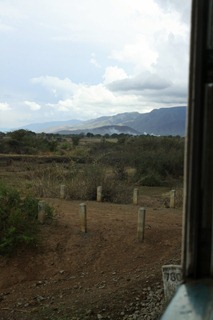 The drinking cabin situated between first and second classes is far from the refined candle-lit colonial train experience I imagined in my youth. Here it is difficult to remember you are on a train at all, as it fills early in the evening with all the trains’ youth turning into as proper a pub as you find on any street in the country. And with so many people stumbling in their usually graceful-but-clumsy-drunken sort of way, you hardly question whether to fault the beer or the train which bounced about as if it were mounting a Russian mountain in search of a warm bed. All the windows held open by strips of wood, except for the one Eugénie stuck her head out to appreciate the landscapes when it tried to decapitate her to the horror of the joyous drinkers around. The youth of the train, as youth everywhere in the world, flirting awkwardly over whiter-than-white trainers, sideways caps, make-up and booze. It impresses me to no end to witness the stumbling of one young man be turned into a sexy sway by the girl who follows him. All the same, the beer was warm. As far as we could understand the explanation, the electricity of the train only works when its moving, and so the refrigerators for the beer wouldn’t be cold until the morning (which is clever since the train only moves two 24 hour periods a week, meaning, unless you’re a breakfast drinker, the beer is always warm!). The cabin has a stunning 30 inch Made-In-China flat-screen television which remains on throughout the day and night. But without anything to play, it only projects the logo of its manufacturer. It was merely 9:00 pm or so when the more zealous of the youths, who had begun two hours before with their plastic baggies of gin (Konyagi), began to drag themselves back to their bunks. How magnificent certain spaces highlight the co-existence of people who have so little to do with one another (as I thought back to the gentlemen in my cabin). I too made my way to bed.
The drinking cabin situated between first and second classes is far from the refined candle-lit colonial train experience I imagined in my youth. Here it is difficult to remember you are on a train at all, as it fills early in the evening with all the trains’ youth turning into as proper a pub as you find on any street in the country. And with so many people stumbling in their usually graceful-but-clumsy-drunken sort of way, you hardly question whether to fault the beer or the train which bounced about as if it were mounting a Russian mountain in search of a warm bed. All the windows held open by strips of wood, except for the one Eugénie stuck her head out to appreciate the landscapes when it tried to decapitate her to the horror of the joyous drinkers around. The youth of the train, as youth everywhere in the world, flirting awkwardly over whiter-than-white trainers, sideways caps, make-up and booze. It impresses me to no end to witness the stumbling of one young man be turned into a sexy sway by the girl who follows him. All the same, the beer was warm. As far as we could understand the explanation, the electricity of the train only works when its moving, and so the refrigerators for the beer wouldn’t be cold until the morning (which is clever since the train only moves two 24 hour periods a week, meaning, unless you’re a breakfast drinker, the beer is always warm!). The cabin has a stunning 30 inch Made-In-China flat-screen television which remains on throughout the day and night. But without anything to play, it only projects the logo of its manufacturer. It was merely 9:00 pm or so when the more zealous of the youths, who had begun two hours before with their plastic baggies of gin (Konyagi), began to drag themselves back to their bunks. How magnificent certain spaces highlight the co-existence of people who have so little to do with one another (as I thought back to the gentlemen in my cabin). I too made my way to bed.
Wednesday, the 11th of November, 2009: It was 5:00 am when nearly two thirds of the train suddenly departed leaving most of the cabins empty (and the third class vaguely spacious). It was not long before stop-after-stop it began to fill in again, though my cabin remained empty except for myself. A few hours later Eugénie was awoken by a fresh batch of ladies (without fish), but she had managed a good rest all the same. The smells of Tanzanian creams, sprays, and gargles filled the corridors from every direction like the phantoms of a morning from a town left behind. The train stopped at each of the most remote and non-descript stations along the tracks. The shock to see those who departed its doors to venture into the “nowhere” of the savannah or into mountains with no paths. And each stop which accompanied a “where” with a name and perhaps a building or two, was the perfect opportunity for every passenger to window shop for their new loaves of bread, eggs, donuts or samosas, boiled corn, knives, snacks, fresh mangoes and bananas, bottles of water, mobile airtime scratch cards, and the like. From around 10:00 am or so onward, a cool rain began to fall. From out the windows, the parched cracking soils of the south began drinking plentifully filling each crevasse with its long awaited sip. We were entering into the rain season, and we watched it arrive through the moving frames of the Tazara.
The train jumped from one viaduct to the next, to the tunnel, to the next. The temperature fell ten degrees or more. Had it been so long since we had the exciting sensation of feeling frozen? The savannah caught itself somewhere upon the horizon till it was tugged away, being replaced by thick greenery and fertile blossoms. It was at just about 4:00 pm when we reached Mbeya’s station and descended to the pungent aroma of mountains, woodstoves, and rain. If we had waited just a few more kilometers we’d had arrived in Zambia. If we took a Dala-Dala a few kilometers, we would have arrived in Malawi. The station of Mbeya was as excessive and unnecessarily large as if it were meant to shame the mountains which surrounded it. Never yet on our journey had I had the feeling of making it so far - thus far.
Vendredi 6 novembre 2009, 8 heures. Depuis un grand boulevard embouteillé de Dar es-Salaam, heuresle passager embourbé dans son dala-dala ne peut manquer d'apercevoir cet immense bâtiment blanc, construction démesurée d'un plus pur style communiste. Au sommet de ce dernier ont été planté six lettres formant le mot TAZARA, version courte pour Tanzania Zambian Railway. Le parking qui s'étend à perte de vue n'abrite que quelques voitures, probablement celles des rares employés présents en cette heure matinale. Le Tazara est le nom du train qui relie deux fois par semaine Dar es-Salaam à la frontière zambienne. Ce matin, le bâtiment est vide, les escaliers monumentaux qui mènent à la plateforme sont décorés par les portraits officiels de différents présidents. Les petits guichets en bois surplombés par de grands ventilateurs ne sont pas pris d'assaut. Le prochain train partira mardi à 15h50, pour ne pas dire 16 h. Le Tazara est le symbole même de la coopération sino-africaine plus en vogue que jamais partout sur le continent. Entre 1970 et 1975, quelques 20 000 chinois et 30 000 tanzaniens ont construit ensemble cette ligne longue de 1870 km. Il y a quelques années circulaient encore deux trains, le train express et celui dit normal. L’express est à ce jour le seul train à faire le trajet en 24 heures, soit le temps mis par ledit normal pour parcourir la même distance à l'époque. La ligne qui traverse la réserve du Selous est souvent le seul moyen d’accès à certaines régions reculées situées bien trop loin des routes. Elle compte 300 viaducs, 147 gares et 24 tunnels.
Mardi 10 novembre 2009, 15 heures. Un message inscrit à la craie sur un tableau noir accueille le passager souvent encombré de ses classiques cartons-sacs-baluchons. Suite à des problèmes non explicités, le train ne partira pas à 16 heures comme prévu mais à 18 heures. Il partira quand même aujourd'hui, on a de la chance. Ce désagrément ne fait qu'en cacher un autre beaucoup plus contrariant : les vendeurs ambulants de cafés-biscuits-œufs durs-journaux-chaussettes-tongs en plastique, sont strictement interdits dans l'enceinte de la gare. Bref, tout ce qui rend l'attente en Afrique surmontable est ici interdit.  Scandale ! Une question m'obsède : pourquoi tous les passagers font-ils de telles réserves de pain de mie industriels ? L'observation de ce monde qui patiente rend paradoxalement l'attente beaucoup plus courte. Vers 17h30 une vague emporte les passagers vers le premier étage où chaque ticket est contrôlé puis griffonné. La salle d'attente est à présent vide, seul un tapis de papier sur le sol rappelle la présence d’une foule impatiente qui s’est précipitée dans le train. Une hôtesse en uniforme accueille le voyageur au pied de chaque wagon, les numéros de cabine et de siège sont apparents, facile à trouver, tout est presque trop parfait.
Scandale ! Une question m'obsède : pourquoi tous les passagers font-ils de telles réserves de pain de mie industriels ? L'observation de ce monde qui patiente rend paradoxalement l'attente beaucoup plus courte. Vers 17h30 une vague emporte les passagers vers le premier étage où chaque ticket est contrôlé puis griffonné. La salle d'attente est à présent vide, seul un tapis de papier sur le sol rappelle la présence d’une foule impatiente qui s’est précipitée dans le train. Une hôtesse en uniforme accueille le voyageur au pied de chaque wagon, les numéros de cabine et de siège sont apparents, facile à trouver, tout est presque trop parfait.
Chaque compartiment de seconde classe compte une dizaine de cabine, une pour les hommes et la suivante pour les femmes et ce jusqu’au bout du wagon. Du coté des hommes tout est calme. Ces messieurs ont au mieux un petit sac à main, mais souvent juste leur veste. Assis sur la banquette du bas, tout le monde discute et fait connaissance, le voyage va être long alors autant commencer à se familiariser avec ses compagnons de cellule. Le "hello" de Seamus ne fait qu’attirer les regards et les sourires inquiets face à tant d'incompréhension, quand il ajoute "mambo", l'atmosphère se détend. Les six hommes attendent le départ du train paisiblement.
Derrière une étroite cloison se trouve un autre monde, celui des femmes. Les quatre mamas déjà débordées me font bien comprendre que mon arrivée ne fait que déstabiliser encore un peu plus leur organisation bancale. En effet, il va falloir redescendre les paquets déjà bien empilés sur ce qui va être ma couchette. Parce que c'est ainsi, je ne manque pas de les aider à entasser leurs baluchons sur leurs propres sièges. Il faut faire vite, le moindre espace disparait en quelques secondes. Une fois les tas de sacs empilés dans l'espace alloué à cette fonction déjà plein à ras-bord, il est temps d'ouvrir le grand papier journal rempli de poissons séchés. Il serait dommage de ne pas profiter du trajet pour parfaire l’affinage des animaux difformes et carbonisés. La fenêtre est fermée mais personne ne se dit qu'il faudrait malgré tout l'ouvrir notamment parce qu’il fait 40 degrés, que trois enfants braillent, que du poisson sèche et que le train est encore en gare. A la nuit tombée l'hôtesse montre aux passagers plongés dans le noir (mais avec la fenêtre à présent ouverte) comment allumer la lumière. Rien de plus simple, il suffit de relier les deux fils électriques dénudés. Quand au ventilateur, il ne fonctionne plus depuis longtemps.
Le wagon-buvette ressemble à n'importe quel bar tanzanien, sauf qu'il est d'une instabilité déconcertante, il bouge comme un petit wagon sur une montagne russe. 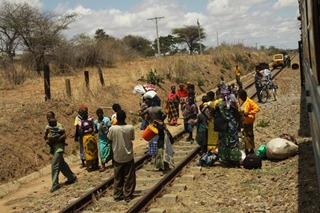 Toutes les fenêtres tiennent avec un morceau de bois sans lequel elles retombent au moindre sursaut et manquent de décapiter le curieux qui prend l'air (moi-même). Le bar devenu le lieu de rassemblement des jeunes du train est bondé. Ces derniers portent des chaussures branchées et des casquettes de travers. Les filles souvent trop maquillées se dandinent dans leurs petits pantalons cintrés en avançant avec prudence. La bière, chaude, y coule à flot, "elle sera fraiche demain matin" précise la serveuse. Tout le matériel de ce wagon date d'un autre âge, tout sauf l'écran neuf et plat made in China qui ne diffuse rien, sauf le nom de la marque. Vers 20 h, les premiers adolescents surexcités commencent à vaciller, sachet d'alcool fort à la main. Dans ce train se concentrent différents petits mondes qui se côtoient mais n'ont rien à voir les uns avec les autres, un peu comme la Tanzanie d'aujourd'hui.
Toutes les fenêtres tiennent avec un morceau de bois sans lequel elles retombent au moindre sursaut et manquent de décapiter le curieux qui prend l'air (moi-même). Le bar devenu le lieu de rassemblement des jeunes du train est bondé. Ces derniers portent des chaussures branchées et des casquettes de travers. Les filles souvent trop maquillées se dandinent dans leurs petits pantalons cintrés en avançant avec prudence. La bière, chaude, y coule à flot, "elle sera fraiche demain matin" précise la serveuse. Tout le matériel de ce wagon date d'un autre âge, tout sauf l'écran neuf et plat made in China qui ne diffuse rien, sauf le nom de la marque. Vers 20 h, les premiers adolescents surexcités commencent à vaciller, sachet d'alcool fort à la main. Dans ce train se concentrent différents petits mondes qui se côtoient mais n'ont rien à voir les uns avec les autres, un peu comme la Tanzanie d'aujourd'hui.
Mercredi 11 novembre 2009. A 5 h du matin le train se vide avant de se remplir aussitôt, du coté des femmes, le vacarme reprend de plus belle. Quelques heures plus tard la fraiche fournée de passagers se réveille, branle-bas de combat dans la cabine ! Les odeurs de crèmes et de lotions en tout genre se mélangent avec celle du poisson encore en train de sécher. Une fois la toilette matinale terminée tout le monde se recouche, il faut dire que l’arrivée n'est pas prévue pour bientôt alors autant poursuivre sa nuit. Le train s'arrête de temps à autre dans des petites gares situées au milieu de nulle part, il est alors temps de faire son marché. Le déjeuner des passagers acheté aux différentes fenêtres se compose de beignets en tout genre, samosas ou mandazis, d'épis de mais bouillis et fruits frais et d'œufs durs. Les paysages défilent sous le soleil ou sous la pluie, le train tangue. Plus nous avançons vers le Sud plus les cours d'eau se vident, le train enchaine les viaducs et les ponts. La température a chuté de dix degrés dans la nuit, nous avions même oublié que cette sensation de fraicheur pouvait exister. La savane s'étend à présent et les baobabs aux bourgeons verdoyants décorent l'horizon. Le train entre en gare vers 16 heures, le nom MBEYA s'affiche alors de manière démesurée sur un bâtiment grandiose planté au pied d'une chaine de montagne. Dans quelques kilomètres, le train s’arrêtera à la frontière zambienne, avant de faire demi-tour.


